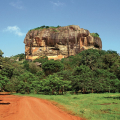SIGIRIYA ROCK (LION ROCK)
The fortress of Sigiriya is registered with the world heritage of UNESCO since 1982. The visit is recommended early in the morning or late in the afternoon to avoid the heat.
History. In the5th century, Dhatusena ruled over Anuradhapura. He had two sons, Mogallana and Kasyapa. In order to obtain the throne which was to be rightfully his elder brother's, Kasyapa first plotted against his father, murdered him, and then expelled Mogallana. Mogallana found refuge in India after swearing that he would return to avenge his father's death. Tormented by this idea, the regicide king quickly decided to leave Anuradhapura and settle in Sigiriya, where he built an impregnable fortress and lived a reclusive life in fear of his older brother's return. Eighteen years later, Mogallana returned at the head of an army and, despite the magnificent work, Kasyapa and his troops were unable to withstand the siege that was inflicted on them. Starving and exhausted, Kasyapa resigned himself to surrender to his brother who executed him. After having taken back the usurped throne, Mogallana abandoned Sigiriya, ephemeral capital from 477 to 495.
The royal gardens.
The path that leads to the foot of the fortress crosses pleasant gardens (water gardens, stone gardens and terraced gardens). Past the magnificent basins, one discovers fallen rocks as well as several cavities undoubtedly intended formerly to shelter monks. One of the most famous is called "Cobra Hood Cave" because of the shape of the rock that overhangs it. All these caves were recently uncovered by excavations conducted by UNESCO.The Demoiselles of Sigiriya. These very famous rock frescoes are to be deserved, they are reached by taking an iron spiral staircase in which it is sometimes necessary to wait patiently, because the number of people who can use it simultaneously is limited. Drawn on the wall of an under-rock shelter, they represent those who were called the Damsels of Sigiriya - if it is said that Kasyapa was surrounded by a thousand courtesans, it is probably more a representation of asparas, these celestial nymphs of the Hindu religion known for their great beauty. Originally, there were some five hundred portraits of young women in the gallery halfway up the hill. Only twenty-one remain today, protected from light and weather, of which a dozen are in a remarkable state of preservation.
The mirror wall.
Continuing towards the top, one passes along a "mirror" wall (the stucco that covers it was originally so perfectly polished that one could look into it). This wall is covered with graffiti, some of which are actually prose and poems written between the 7th and 18th centuries by illustrious visitors.The door of the lion.
We then reach a plateau where the lion's gate is located. Of the giant statue of the lion which stood guard and undoubtedly terrified the visitors, it remains only the imposing legs resting on both sides of a first staircase. It is then necessary to take again the ascent by climbing the steps of a metallic staircase sealed in the rocky wall.The summit.
By reaching the top of the rock, at a height of 180 m, we notice that there is only little left of the palace: some foundations and a part of the staircase... Only the royal swimming pool is perfectly preserved.Did you know? This review was written by our professional authors.
Book the Best Activities with Get Your Guide
Members' reviews on SIGIRIYA ROCK (LION ROCK)
The ratings and reviews below reflect the subjective opinions of members and not the opinion of The Little Witty.


Par contre le prix est beaucoup élevé pour ce que c'est
La visite débute par l’allée centrale qui mène au pied de la forteresse est bordée par les jardins et bassins royaux
Ensuite, départ pour l'ascension de la forteresse 1 232 marches, qui se fait en 3 étapes
1ère étape l'ascension par des escaliers métalliques en colimaçon assez impressionnants pour aller à la galerie des Demoiselles de Sigiriya de toute beaut. Dommage on ne peut pas prendre de photos
2ème étape Il faudra encore traverser plusieurs passerelles suspendues à flan de parois avant d’atteindre la plateforme du lion. Il ne reste que les pattes monumentales. En chemin, on peut apercevoir deux gros nids de frelons.
3ème étape après avoir monté les escaliers qui sont à flans de parois, suspendus dans le vide. On arrive en haut de la forteresse avec une vue époustouflante, la jungle, les lacs, les montagnes à perte de vue… Du palais, il ne reste que des ruines. On est libre de s’y balader sans aucune restriction.
si vous voulez acheter une boite secrete en bois, il y a plein de vendeur sur place
Les quelques 1000 marches se font aisément, cela est bien fait, pas trop pentues!
Un site incroyable, historique ,et une vue en arrivant en haut à couper le souffle!
Un panorama fait de végétation, on se sent tout petit!